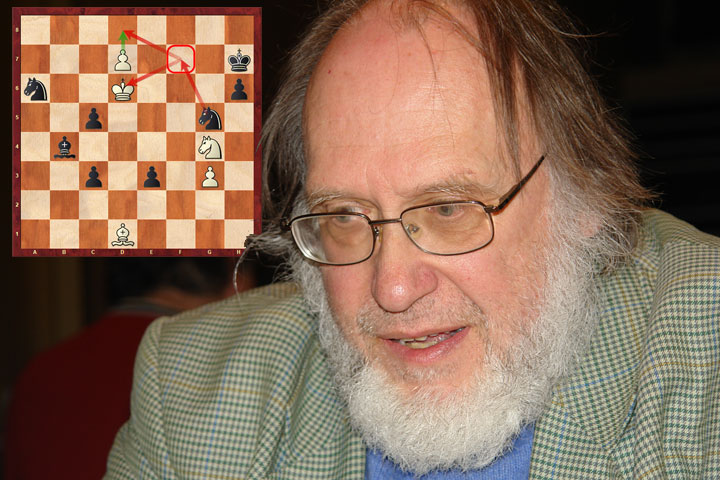


Last week we presented a study shown to us by IM Hans Böhm in the restaurant of the Zeeduin Hotel, during the Tata Steel tournament in Wijk aan Zee. Together with a Belgian couple, Rita Loos and Michele Magoga, we worked for maybe half an hour on the position, with Hans refuting every wrong try.
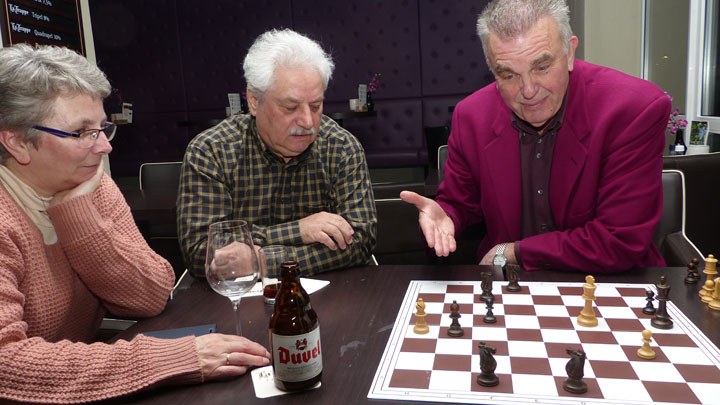
In the image published in last week's article I had blurred out the position so as not to offer any help to our readers, who were to solve the problem themselves, with the help of their chess engines, if they so wished. Before I come to the solution some background to the study is in order.
First of all it is amazing (and expedient) that human — well, at least my memory is so frail. That evening, in my hotel room, I was looking for the exact source of the study when I discovered that I had published it myself, a long time ago. I will retell the story
In April 1987 there was a super-GM tournament in Brussels, one that was won by the great Jugoslav GM Ljubo Ljubojevic, who finished equal first with World Champion Garry Kasparov. They were one and a half points ahead of Anatoly Karpov and the rest of the field, which included Tal, Larsen, Kortschnoj, Timman and a very young and off-form Nigel Short.
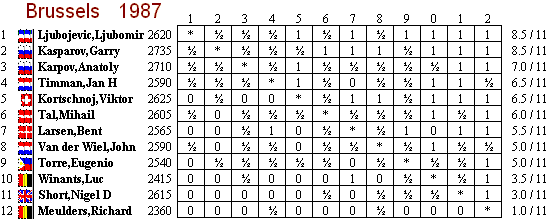
The tournament was memorable for a specific reason. The very first version of ChessBase had been released in January 1987, and we were showing the database program to the players at the tournament. Kasparov and Short knew it already, but for the others it was like taking kids through a candy store. Mikhail Tal was the greatest fun: he would always come to the press room immediately after his games to enter the moves into my Atari ST (1 MByte RAM, 720 KB disk drive, ask gramps about this legendary machine).
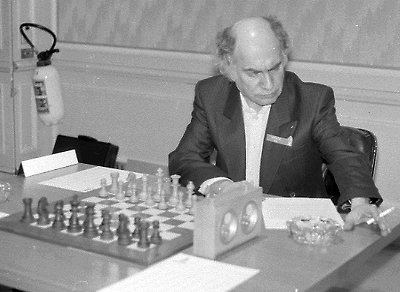
Mikhail Tal at the super-GM tournament in Brussels in 1987
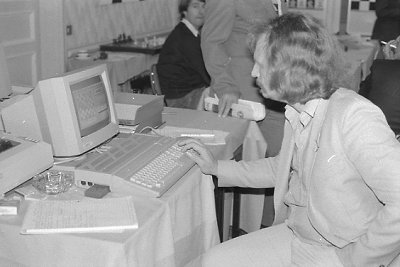
Tony Miles checking out the revolutionary new database program in 1987
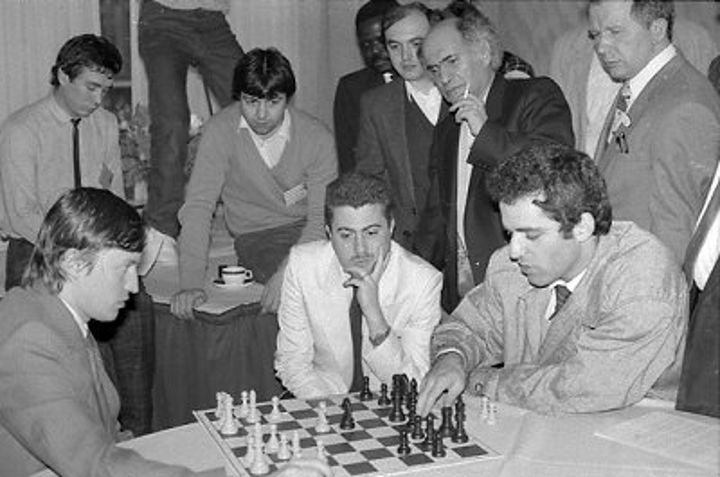
Karpov and Kasparov analysing after their game, sans computer, with Bachar Kouatly (seated) and Mikhail Tal (standing with cigarette)
The other memorable thing was an encounter with a very intense young British grandmaster. By a remarkable coincidence (insider joke) James Plaskett (pictured at left) was visiting the tournament, and I spent a lot of time arguing right-wing English politics with him. As a parting gift Jim showed me the study below, the same one shown to us thirty years later by Hans Böhm.
In Brussels we spent the rest of the day shuffling the pieces around on the board. Occasionally one of the super-GMs would come in after his game, and sometimes they would join in the analysis. But nobody got it in the press room. Misha Tal worked on it unsuccessfully for ten minutes, then left the press room and then suddenly popped in again, an hour later. He had figured out the main idea during a walk in the park.
When I published the study in the ChessBase Puzzle section (a static page that is no longer online), I mirrored the position to make it more difficult for readers to find it on the Internet or in study databases. I did the same in the article last week. Only a few dozen readers were able to find the solution — with intense use of chess engines and ingenious searches on the Internet.
Let us now take a look at the remarkable study in its original form. Remember that you can move the pieces around on the board to visualize the moves given below the diagrams. At the end of this article the entire solution is provided in a ChessBase game viewer, which even allows you to start an engine to analyse any ideas you might like to try.
We mentioned a few obvious things in the above position. White cannot promote the pawn because of the knight fork on f7. Moving the king allows Black to defend the queening square d8 and use his own superior forces to settle the game.
So White had to take more drastic measures: 1.Nf6+ Kg7! 1...Kh8 2.d8Q+ is mate in four; and 1...Kg6 2.Bh5+ Kxf6 (or ...Kf5) 3.d8Q wins, as the forking square f7 is defended by the bishop. 2.Nh5+ Kg6. 2...Kf7 would block the forking square and allow 3.d8Q. 3.Bc2+! Forcing Black to take the knight – a very difficult move for computers to find. 3…Kxh5 4.d8Q!! (allowing the fork) Nf7+ 5.Ke6 Nxd8+ 6.Kf5.
Move the pieces directly on the diagram!
Aha, White has cast out a mate net! The threat is 7.Bd1+ e2 8.Bxe2 mate. 6…e2 7.Be4. Now the threat is 8.Bf3#. Black has only one reasonable defence — underpromotion! 7…e1N! 8.Bd5! Threat: 9.Bc4 and 10.Be2 with mate to follow. 8...c2 9.Bc4. Threatening 10.Be2 with mate in two. 9…c1N! 10.Bb5. Threatening 11.Be8+ with mate in two. 10…Nc7 11.Ba4!
Look at this situation. Black has four knights (and a bishop), but cannot stop the lone white bishop from delivering mate in three moves, e.g. 11…Ne2 12.Bd1 Nf3 13.Bxe2 and 14.Bxf3 mate.
A beautiful, fascinating problem, praised by many readers. Paulo Guilherme de Mattos of Guarulhos-Brazil, wrote: "Wow, this puzzle is insane"; Roberto Dillon of Singapore called it "a truly devilish study!"; George Georgopoulos of Athens Greece says it took him a full day to solve, with engine help; while Dominic Lehane of Brisbane, Australia, wrote: "After two days analyzing in my spare time I managed to solve this puzzle without computers. It is the longest puzzle that I have ever solved and the most interesting as well."
How I lost my bet with Hans Böhm: at one stage he said that computers could never solve the study, and I bet him that my Fritz 16 would do it in less than one minute. I fetched my notebook and voilá, I had the solution almost instantaneously. Hans was impressed and started to order a beer, but honest as I am (often to my own disadvantage) I confessed and showed him how I had done it:
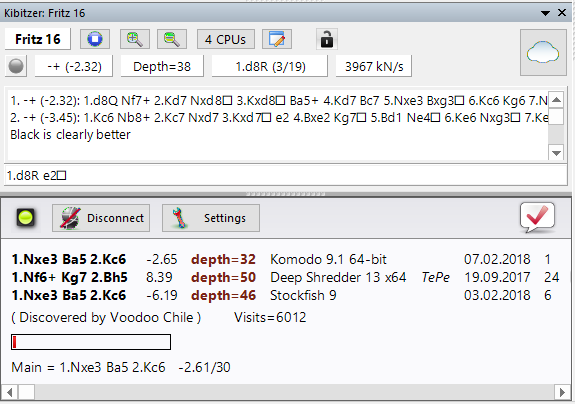
This is Fritz 16 working on the initial study position and contemplating 1.d8Q and 1.Kc6 with losing evaluations for White. But: Let's Check, our cloud collection of hundreds of millions of positions, with analysis by three powerful engines, showed me that some people had already looked at the position, and that one program had come up with the 1.Nf6+ try. I entered this move and the reply ...Kg7, and this is what I got:
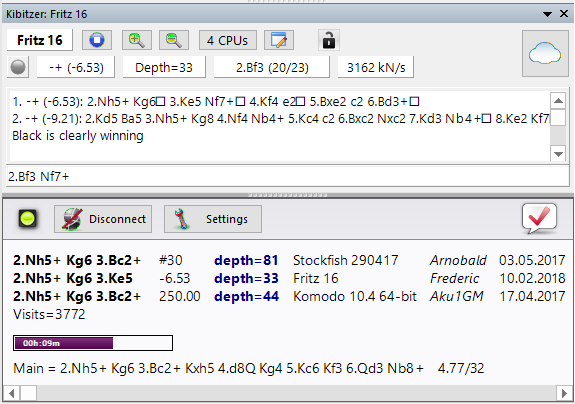
Fritz 16, after a few minutes, is still trying to find a positive continuation, but someone had analysed the position after 1.Nf6+ Kg7 down to 44 ply with Komodo and 81 ply with Stockfish, and come up with the full solution (as you can see from the evals). Of couse I was able to dictate the continuation to Hans with zero seconds delay, but not because of raw engine power, but thanks to information stored in the cloud. So I bought the beer.

[Event "Schakend Nederland#2207 (v)"] [Site "?"] [Date "1990.??.??"] [Round "?"] [White "Van Breukelen, Gijs"] [Black "White to play and win"] [Result "1-0"] [Annotator "Bohm,Hans"] [SetUp "1"] [FEN "8/3P3k/n2K3p/2p3n1/1b4N1/2p1p1P1/8/3B4 w - - 0 1"] [PlyCount "27"] [EventDate "1990.??.??"] 1. Nf6+ Kg7 (1... Kg6 $2 2. Bh5+ Kxf6 3. d8=Q+) 2. Nh5+ (2. Bh5 Ba5 $19) 2... Kg6 3. Bc2+ $1 Kxh5 4. d8=Q $1 Nf7+ (4... Kg4 5. Qf6 Kxg3 6. Qe5+ Kf2 7. Qh2+ Ke1 8. Qg1+ Ke2 9. Qg4+ Ke1 10. Ke5) 5. Ke6 Nxd8+ 6. Kf5 {Threat: 7.Bd1+ e2 8. Bxe2#} e2 7. Be4 {Threat: 8.Bf3#} e1=N $1 8. Bd5 $1 {Threat: 9.Bc4 and 10.Be2 with mate to follow.} c2 9. Bc4 {Threat: 10.Be2+ and mate.} c1=N $1 10. Bb5 { Threat: 11.Be8+ and mate.} Nc7 11. Ba4 $1 {Threat: 12.Bd1+ and mate to follow.} Ne2 12. Bd1 Nf3 13. Bxe2 Nce6 {Any.} 14. Bxf3# 1-0
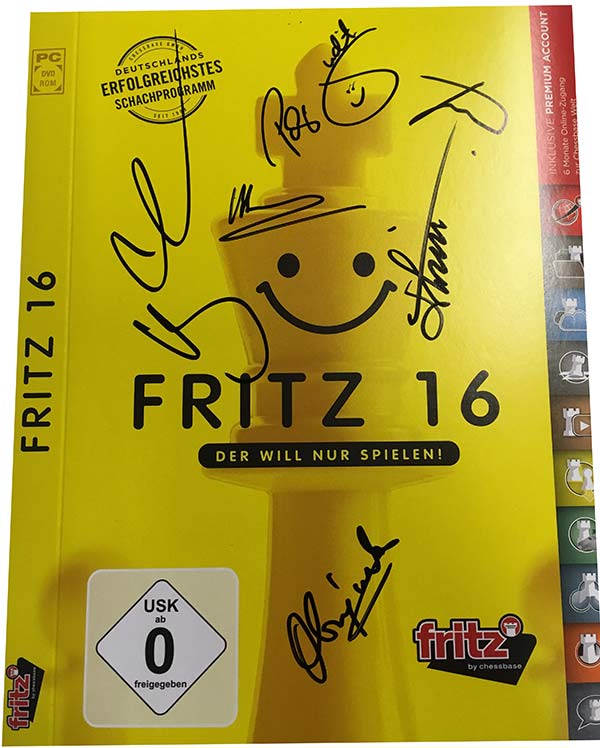
The prize, a copy of copy of Fritz 16 signed by Magnus Carlsen, Anish Giri, Viswanathan Anand, Judit Polgar, Shakhriyar Mamedyarov and Vidit Gujarathi, was won by Dominic Lehane of Brisbane, Australia
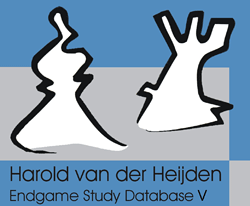 The database of Harold van den Heijden, which currently contains 85,619 endgame studies (Harold has devoted a good part his life to their compilation) and costs just 50 Euros to purchase, gives the author of the study as Gijs van Breukelen, and the place of publication as the Dutch magazine Schakend Nederland. The date given is baffling: 1990. But didn't Jim Plaskett show it to us in 1987? And clearly a number of people had seen the study before that. For instance GM Lubomir Kavalek told me:
The database of Harold van den Heijden, which currently contains 85,619 endgame studies (Harold has devoted a good part his life to their compilation) and costs just 50 Euros to purchase, gives the author of the study as Gijs van Breukelen, and the place of publication as the Dutch magazine Schakend Nederland. The date given is baffling: 1990. But didn't Jim Plaskett show it to us in 1987? And clearly a number of people had seen the study before that. For instance GM Lubomir Kavalek told me:
"I had fun solving this problem with Boris Spassky during a Bundesliga weekend in the early 1980s. I don’t know who showed it to us."
The situation was further complicated by stories about Misha Tal being given the position by a taxi or lorry-driver whom he was never able to track down. These stories contradict my recollection of Tal seeing the position in Brussels in April 1987, not being able to solve it and then suddenly coming back to the press center with the solution.
The leading endgame expert, John Roycroft, wrote in the endgame magazine EG vol. 122:
The composer of this fine study is the Dutch composer Gijs van Breukelen, who demonstrated it as an example of his own work at a meeting of ARVES held in 1992 in Delft. The composer said at the ARVES meeting that he had composed it in the mid-1970s and shown it to several friends, but had neither sent it for publication nor entered it for a tourney. Having somehow penetrated the player circuit it circulated rapidly, acquiring journalistic colour en route through being associated either with a (totally fictitious) Ukrainian tractor-driver, or with a very specific (but equally spurious) game between leading masters. The late IGM Tal was one of the active propagators, but when asked he claimed he could not remember who had first shown it to him.
Jim Plaskett wrote me, back in 2003:
There is an obscure mythology about the puzzle’s provenance. I think Graham Hillyard was the first person to show it to me, in 1986, or earlier. The study appears in Gufeld’s last book, The Search for Mona Lisa. His story is that it pops up circa 1990. There are stories of Tal having received an anonymous letter, pre 1986, of a lorry driver having composed it. Gufeld says that since nobody has yet claimed to be the inventor of the study, he proposes that it dropped in from outer space. I am sure I read somewhere that sombody ending in -shvili did it. He says that during the 1992 Olympiad the Malaysian player MokTze Meng received an anonymous phone call saying that here was a gift for Gufeld — and the voice then dictated the position. Gufeld says that at the 1992 Olympiad both Karpov and Kasparov were amazed by the study.
Antonio Torrecillas of Barcelona wrote:
This problem was shown to me with a nice story a lot of years ago: a truck driver sent it to a some Russian magazine (maybe 64?), but it was put in the storage files for a long while. Years ago Mikhail Tal, as a director of that magazine, saw it and enjoyed it very much. But when Tal tried to find the composer of that fantastic endgame he couldn’t, because the driver was dead. The only problem of that story is that it is false, but it’s very nice anyway!
What does one do in such situations? Well obviously the best strategy is to contact the endgame study king Harold van den Heijden. He provided the following information:
What is known about the oldest source? A. Ruygrok reported that the problem was immortalized in 1976 by the well-known insect painter Hans Verhoef in the TV show Voor de vuist weg. The weekly Panorama also published the diagram with commentary by Hans Böhm. A while back Hans gave me a copy of an article about a visit by him and Harm Wiersma, six-time world champion in draughts, to Hans Verhoef. And yes: the picture depicts the tractor problem. It should be noted that in 1976 the story about the tractor had apparently not yet been invented. Hans Böhm gave me a nice picture in which also the chess painting was immortalized:
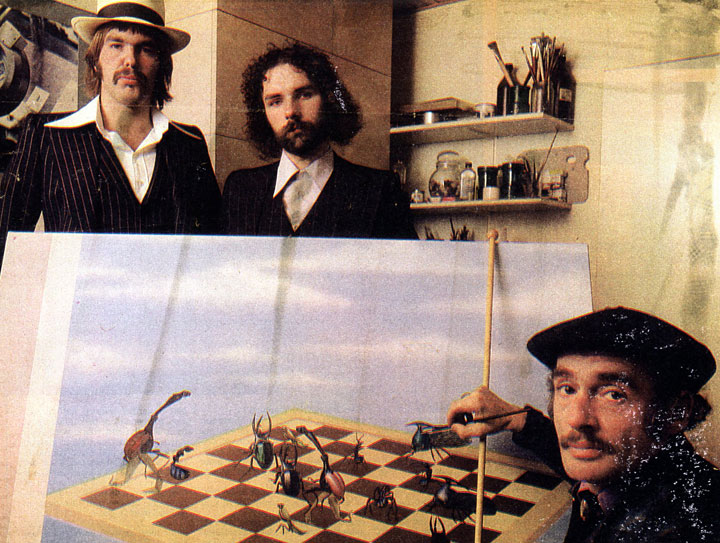
A scan of the picture with the painting by artist Hans Verhoef. In the background: Hans Böhm and Harm Wiersma. "Unfortunately, the print of the picture is somewhat damaged," Harold wrote.
So what about Mikhail Tal? I am convinced that he saw the position for the first time in the press room in Brussels. His demeanor while trying to solve it, and then after finding the solution in the park, looked completely genuine. I conclude that others have fabricated the completely fictitious tractor-driver story.
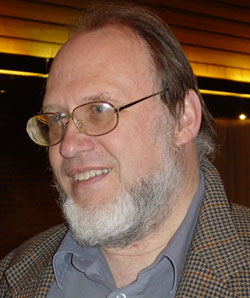 About Gijs van Breukelen
About Gijs van BreukelenBorn in Amsterdam in 1946, he began chess composition at the age of seventeen. He studied Dutch language in Utrecht, and played for the chess club "Paul Keres". He admires Liburkin, Kasparyan and Marwitz.
In his early studies the influence of naturalism can be seen. Later his style became more eccentric with a preference for lengthy solutions.
A selection of his studies can be found here. All van Breukelen studies, with exact dates, possible corrections or cooks and exact details about sources can be found in the Harold van den Heijden Studies Database.
Photos of Gijs van Breukelen: René Olthof (2010, title), Harold van der Heijden (2002)
Photos of super-GM tournament in Brussel 1987, Wijk 2018: Frederic Friedel
| Advertising |